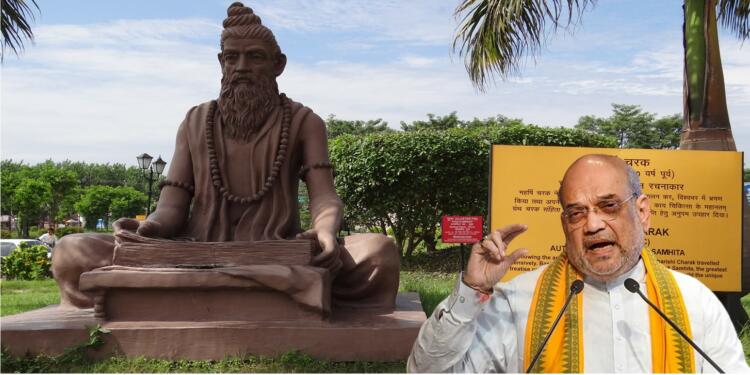People believe that language does not affect technical fields such as medical and engineering. It is not true though. It is the anglicisation of language in textbooks which paved the way for the disappearance of medical texts such as Charak Sanhita from our medical education. A contrary movement is taking shape towards reviving its legacy.
Medical textbooks in Hindi
Home Minister Amit Shah will soon launch 3 medical textbooks. The remarkable feature of these textbooks is that they will be available in Hindi. Blood and Sweat has been poured to translate anatomy, biochemistry and physiology books in Hindi. Home Minister Shah will be inaugurating them at Bhopal’s Lal Parade ground on October 16.
The project was first announced by Madhya Pradesh CM Shivaraj Singh Chauhan in February this year. But the challenge was that simple translation would not work since words involved in medical textbooks are hyper technical in nature. Maintaining precision and avoiding tampering was also a mandatory requirement. To solve the problem, a task force was formulated.
Not an easy task
This task force consulted with lecturers and senior professionals. Public opinions were also sought after through government portals. Additionally, it also looked into the methodologies of translation adoption in countries such as Germany and China. Towards the end of this process, the task force understood that a plane translation would not do. Instead, transliteration also became part of the process. Technical words such as blood pressure, spine, femur, angioplasty, DNA, stomach and many others were simply written in Devnagri script, without tinkering with them.
Vikram Singh for anatomy, Indu Khurana for physiology and Dinesh Puri for biochemistry are the 3 publishers of these books. After getting permission from these 3 dignitaries, meetings with medical education staffers were held to appoint team for transliteration. Vishwas Sarang, Medical Education Minister of state said, “After the first round of meetings, 97 people were identified who were divided into three groups — one each for each of the three subjects — and they were provided with books roughly translated from English to Hindi, which was done using software,”
After transliteration, the work was sent to a validation committee. The committee comprising subject matter experts and teachers passed it. According to the plan, separate batches for Hindi and English medium students will be organised. Initially, these textbooks will only be available to students of Government medical Colleges and then expanded to 13 other colleges. It is pertinent to note that the move is in accordance with the National Education Policy, 2020.
Mixed reactions
The medical fraternity has mixed reactions about the project. While 2,500 students will be flocking from Indore to Bhopal for the inauguration, there are concerns regarding job prospects. Members of Federation of the All-India Medical Associations (FAIMA), a body of postgraduate medical students and doctors have said that the move will handicap people as medical education is available in English language. Others said that it only makes entry easier for experts of vernacular language, but ultimately, they will have to learn to comprehend in English.
The mechanism of language being bedrock of medical education
These are initial criticisms and will most likely subside by the time translation is launched for second year students. The more rapidly students adapt to it, more chances will be that the phenomenon will dominate medical education. This is exactly the process of how English ended up being the dominant language of medical education. Allopathy originated from heroic medicines in Europe and North America. Due to English being the local language, the documentation of the form of medicines in practical use came in English.
Read more:-Here is how Ayushman Bharat is helping to boost Indian economy
Soon, a medical community around the system was developed. To ensure quality, peer review was introduced. For this purpose, various Journals came into existence. Since colonialism was at its height during those days, even people from colonised nations needed to have command over English to communicate about their discoveries and other breakthroughs. Through Journals such as CA-A Cancer Journal for Clinicians, New England Journal of Medicine, The Lancet Journal, Journal of the American Medical Association, Journal of Clinical Oncology, Nature Medicine, British Medical Journal, Cancer Cell Journal; English became the language of medical education all across the world.
Will revive traditional Indian medical education
It also affected local medical texts such as Charak Sanhita, Sushruta Samhita, Kashyap Samhita among others that lost their traction. The advent of the English language made these texts inaccessible to masses. Along with them, Indians’ traditional way of healthy lives such as Ayurved, Yoga, Naturopathy, Unani, Siddha also got neglected for quite a long time.
Though, Modi government’s emphasis on AYUSH (Ayurveda, Yoga and Naturopathy, Unani, Siddha and Homoeopathy) education has brought some positive changes, a radical shift was required to make them accessible to the masses. Introduction of Hindi language in medical education is the first such step.
Support TFI:
Support us to strengthen the ‘Right’ ideology of cultural nationalism by purchasing the best quality garments from TFI-STORE.COM































